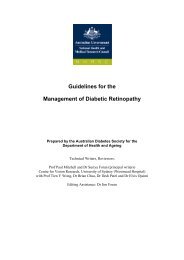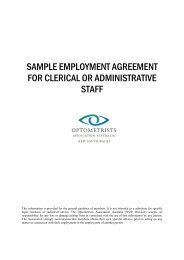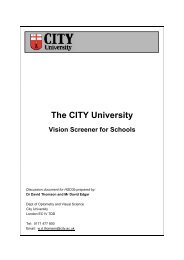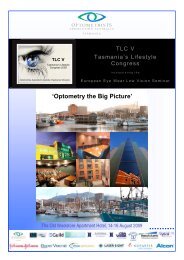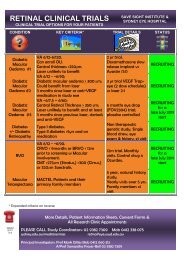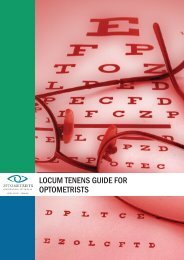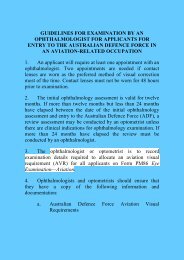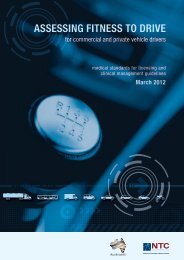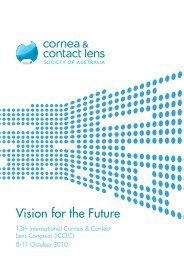Eye health in the workplace - a guide for PCBUs and ... - Comcare
Eye health in the workplace - a guide for PCBUs and ... - Comcare
Eye health in the workplace - a guide for PCBUs and ... - Comcare
Create successful ePaper yourself
Turn your PDF publications into a flip-book with our unique Google optimized e-Paper software.
EYE HEALTH IN<br />
THE WORKPLACE<br />
A <strong>guide</strong> <strong>for</strong> <strong>PCBUs</strong><br />
<strong>and</strong> workers
Disclaimer<br />
This <strong>guide</strong> provides a basic <strong>and</strong> general overview of its subject<br />
matter only. It is not a substitute <strong>for</strong> <strong>in</strong>dependent legal advice <strong>and</strong><br />
cannot be relied on as a statement of <strong>the</strong> law relat<strong>in</strong>g to <strong>the</strong> Work<br />
Health <strong>and</strong> Safety Act 2011 (Cth). <strong>Comcare</strong> recommends duty<br />
holders obta<strong>in</strong> appropriate <strong>in</strong>dependent legal advice relevant to <strong>the</strong>ir<br />
particular needs <strong>and</strong> circumstances.<br />
Publication details<br />
© Commonwealth of Australia 2012<br />
This work is copyright. Apart from any use permitted under <strong>the</strong><br />
Copyright Act 1968, no part can be reproduced by any process<br />
without written permission from <strong>Comcare</strong>.<br />
ISBN 1 876700 94 7 (onl<strong>in</strong>e)<br />
First published December 2005<br />
Second edition November 2008<br />
Third edition November 2010<br />
Fourth edition December 2011<br />
Fifth edition February 2012<br />
<strong>Comcare</strong><br />
GPO Box 9905<br />
Canberra ACT 2601<br />
Phone 1300 366 979<br />
www.comcare.gov.au
CONTENTS<br />
INTRODUCTION 4<br />
Purpose 5<br />
Scope <strong>and</strong> application 5<br />
Risk management 6<br />
Implementation 6<br />
DUTY OF CARE AND THE GENERAL MANAGEMENT OF EYE HEALTH 8<br />
PCBU’s role 8<br />
Worker’s role 10<br />
Costs 10<br />
VISUALLY DEMANDING WORK 12<br />
SCREEN WORK 14<br />
VISION-CRITICAL TASKS 17<br />
WORK INVOLVING PHYSICAL RISKS OF EYE INJURY 18<br />
REFERENCES AND FURTHER INFORMATION 19<br />
GLOSSARY OF TERMS 21
4<br />
INTRODUCTION<br />
The purpose of this publication<br />
is to assist <strong>PCBUs</strong>, safety<br />
practitioners, managers,<br />
supervisors <strong>and</strong> workers<br />
cooperatively manage eye<br />
<strong>health</strong> <strong>in</strong> <strong>the</strong> <strong>workplace</strong>.<br />
This publication provides basic <strong>in</strong><strong>for</strong>mation that will help <strong>PCBUs</strong><br />
<strong>and</strong> workers assess risks to eye <strong>health</strong>, manage eye <strong>health</strong> <strong>in</strong><br />
<strong>the</strong> <strong>workplace</strong> <strong>and</strong> deal with safety issues.<br />
Visual impairment can reduce <strong>health</strong> <strong>and</strong> wellbe<strong>in</strong>g, affect a<br />
person’s ability to work, drive <strong>and</strong> per<strong>for</strong>m normal activities<br />
such as read<strong>in</strong>g or watch<strong>in</strong>g television. The effects of visual<br />
impairment or <strong>in</strong>jury can reduce mobility—<strong>in</strong>creas<strong>in</strong>g <strong>the</strong> risk of<br />
falls <strong>and</strong> <strong>in</strong>jury—<strong>and</strong> reduce a person’s <strong>in</strong>dependence. This can<br />
contribute over time to isolation <strong>and</strong> depression, affect<strong>in</strong>g <strong>the</strong><br />
worker’s work <strong>and</strong> social relationships (NHMRC 2008).<br />
More than 300 million people worldwide are estimated to live<br />
with low vision <strong>and</strong> bl<strong>in</strong>dness from any cause. This imposes<br />
social <strong>and</strong> economic burdens on <strong>in</strong>dividuals, families, societies<br />
<strong>and</strong> nations (Yiengprugsawan V 2010, WHO 2004).<br />
Dur<strong>in</strong>g <strong>the</strong> National <strong>Eye</strong> Health Initiative of 2006–2010, <strong>the</strong><br />
most common diagnosis <strong>for</strong> eye-related <strong>in</strong>jury compensation<br />
claims <strong>in</strong> Australia was a <strong>for</strong>eign body on <strong>the</strong> external eye—<br />
with eye <strong>in</strong>juries more common <strong>for</strong> males than <strong>for</strong> females,<br />
particularly those of work<strong>in</strong>g age. This type of <strong>in</strong>jury accounts <strong>for</strong><br />
59 per cent of eye-related claims (<strong>Comcare</strong> data). Median time<br />
lost from work because of a <strong>for</strong>eign body <strong>in</strong> <strong>the</strong> eye was 1.5<br />
weeks (AIHW 2009).
5<br />
Although emerg<strong>in</strong>g technologies improve efficiency <strong>in</strong> everyday<br />
life, prolonged use of electronic devices may lead to symptoms<br />
of Computer Vision Syndrome (CVS) such as eye stra<strong>in</strong>, dry<br />
eyes, headaches, fatigue, blurred vision, <strong>and</strong> loss of focus.<br />
CVS can be a serious problem <strong>for</strong> people who spend many<br />
hours each day <strong>in</strong> front of a computer or on smaller screens<br />
like laptops or h<strong>and</strong>held electronic devices (Blehm et al 2005,<br />
Uch<strong>in</strong>o et al 2008). As an <strong>in</strong>dication of <strong>the</strong> extent of <strong>the</strong> problem<br />
<strong>in</strong> developed countries, like Australia, it is estimated that <strong>in</strong><br />
<strong>the</strong> USA nearly 46 per cent of <strong>the</strong> population spend five or<br />
more hours per day us<strong>in</strong>g a computer or PDA (personal digital<br />
assistant) (AOA 2010). Up to 48 per cent of Australian office<br />
workers suffer from computer-related eye fatigue, a rate which<br />
appears to be <strong>in</strong>creas<strong>in</strong>g. Excessive computer use can cause<br />
eye stra<strong>in</strong> <strong>and</strong> reduce productivity (Optometrists Association<br />
Australia 2010).<br />
Commonwealth agencies have a statutory obligation to protect<br />
<strong>the</strong> <strong>health</strong> <strong>and</strong> safety of workers. Section 19 of <strong>the</strong> Work Health<br />
<strong>and</strong> Safety Act 2011 (Cth) (WHS Act) states a PCBU must<br />
ensure—so far as is reasonably practicable—<strong>the</strong> <strong>health</strong> <strong>and</strong><br />
safety of <strong>the</strong>ir workers while <strong>the</strong>y are at work.<br />
PURPOSE<br />
This publication provides general advice <strong>and</strong> guidance <strong>for</strong><br />
manag<strong>in</strong>g eye <strong>health</strong>. The purpose of this publication is to assist<br />
<strong>PCBUs</strong> <strong>and</strong> <strong>the</strong>ir workers cooperatively ensure safe work<strong>in</strong>g<br />
environments, without risks to <strong>the</strong> <strong>health</strong> of workers, contractors<br />
or o<strong>the</strong>r persons <strong>in</strong> or near <strong>workplace</strong>s.<br />
The <strong>in</strong>tended results are:<br />
> acceptance of eye <strong>health</strong> management as an important part<br />
of ma<strong>in</strong>ta<strong>in</strong><strong>in</strong>g a <strong>health</strong>y <strong>and</strong> safe <strong>workplace</strong><br />
> workers can com<strong>for</strong>tably per<strong>for</strong>m visually dem<strong>and</strong><strong>in</strong>g work<br />
> workers can demonstrate <strong>the</strong> eyesight st<strong>and</strong>ards necessary<br />
<strong>for</strong> <strong>the</strong> safe per<strong>for</strong>mance of vision-critical tasks<br />
> controls are <strong>in</strong> place to elim<strong>in</strong>ate or m<strong>in</strong>imise <strong>the</strong> risk of eye<br />
<strong>in</strong>jury.<br />
SCOPE AND APPLICATION<br />
Under <strong>the</strong> WHS Act, <strong>PCBUs</strong>, workers <strong>and</strong> o<strong>the</strong>r persons have<br />
responsibilities to ensure <strong>the</strong> <strong>health</strong> <strong>and</strong> safety of people at work.
6<br />
RISK MANAGEMENT<br />
This <strong>guide</strong> is not a substitute <strong>for</strong> undertak<strong>in</strong>g organisational<br />
risk management. The WHS Act <strong>and</strong> regulations use risk<br />
management as <strong>the</strong> primary means <strong>for</strong> controll<strong>in</strong>g risks. Risk<br />
management is a four step process to:<br />
> identify <strong>the</strong> hazard<br />
> assess <strong>the</strong> risk associated with <strong>the</strong> hazard<br />
> control <strong>the</strong> risk<br />
> monitor <strong>and</strong> review <strong>the</strong> process.<br />
To be effective, risk management requires <strong>the</strong> commitment<br />
<strong>and</strong> cooperation of all parties <strong>in</strong>volved <strong>and</strong> should become an<br />
<strong>in</strong>tegral part of an organisation’s culture, bus<strong>in</strong>ess practices <strong>and</strong><br />
processes.<br />
IMPLEMENTATION<br />
<strong>PCBUs</strong> <strong>and</strong> workers (<strong>and</strong>/or <strong>the</strong>ir representatives) are<br />
encouraged to develop a policy based on this <strong>guide</strong> <strong>and</strong> to<br />
dissem<strong>in</strong>ate it <strong>for</strong> access <strong>and</strong> reference by all managers,<br />
supervisors <strong>and</strong> workers. This document is not <strong>in</strong>tended to<br />
override or replace exist<strong>in</strong>g agreements between <strong>PCBUs</strong>, workers<br />
<strong>and</strong> <strong>the</strong>ir representatives.
8<br />
DUTY OF CARE AND THE<br />
GENERAL MANAGEMENT OF<br />
EYE HEALTH<br />
You can apply <strong>the</strong> follow<strong>in</strong>g<br />
general advice to work that<br />
<strong>in</strong>volves dem<strong>and</strong><strong>in</strong>g visual<br />
tasks or has an elevated risk of<br />
eye <strong>in</strong>jury.<br />
The effective management of eye <strong>health</strong> is an important<br />
contribution to a <strong>health</strong>y <strong>and</strong> safe <strong>workplace</strong>.<br />
Workers may experience eye <strong>health</strong> problems <strong>for</strong> a variety of<br />
reasons where <strong>the</strong> PCBU does not have any responsibility—<br />
<strong>for</strong> example, permanent eyesight deterioration due to normal<br />
age<strong>in</strong>g. Workers may have a pre-exist<strong>in</strong>g eyesight problem<br />
that has not been resolved. While not responsible <strong>for</strong> <strong>the</strong>se<br />
eye <strong>health</strong> issues, <strong>PCBUs</strong> can encourage workers to look<br />
after <strong>the</strong>ir eye <strong>health</strong> <strong>and</strong> may have a duty to ensure that <strong>the</strong><br />
problem is not aggravated by work circumstances, or leads to<br />
consequential issues.<br />
<strong>PCBUs</strong> should exam<strong>in</strong>e <strong>the</strong> <strong>workplace</strong> to assess if <strong>the</strong>re<br />
are any hazards that could contribute to eye discom<strong>for</strong>t <strong>for</strong><br />
workers. <strong>PCBUs</strong> could develop checklists <strong>for</strong> specific work<br />
environments—<strong>for</strong> example, work conducted outdoors, driv<strong>in</strong>g<br />
or <strong>in</strong> high risk environments. Such checklists may <strong>in</strong><strong>for</strong>m of<br />
action to improve <strong>the</strong> work environment.<br />
PCBU’S ROLE<br />
<strong>PCBUs</strong> have a duty of care under section 19 of <strong>the</strong> WHS Act<br />
which states that a PCBU must ensure—so far as is reasonably<br />
practicable—<strong>the</strong> <strong>health</strong> <strong>and</strong> safety of <strong>the</strong>ir workers while at work.<br />
A PCBU must provide personal protective equipment (PPE) to<br />
workers where <strong>the</strong> PPE is <strong>for</strong> m<strong>in</strong>imis<strong>in</strong>g a risk to <strong>health</strong> <strong>and</strong><br />
safety (section 44 Model Work Health <strong>and</strong> Safety Regulations<br />
2011). Under section 273 of <strong>the</strong> WHS Act, <strong>the</strong> PCBU must<br />
provide PPE at no cost to <strong>the</strong>ir workers.<br />
A serious eye <strong>in</strong>jury is a ‘serious <strong>in</strong>jury or illness’ under section<br />
36 of <strong>the</strong> WHS Act <strong>and</strong> any <strong>in</strong>cident result<strong>in</strong>g <strong>in</strong> a serious eye<br />
<strong>in</strong>jury is a ‘notifiable <strong>in</strong>cident’ under section 35 of <strong>the</strong> WHS Act.
9<br />
<strong>PCBUs</strong> should:<br />
> do all that is reasonably practicable to ensure <strong>health</strong>y <strong>and</strong><br />
safe work<strong>in</strong>g environments <strong>and</strong> m<strong>in</strong>imise <strong>the</strong> risk of eye<br />
<strong>in</strong>jury through safe work practices<br />
> identify work tasks that <strong>in</strong>volve an elevated risk of <strong>in</strong>jury<br />
> ensure that appropriate PPE is provided to workers at risk of<br />
eye <strong>in</strong>jury or damage—<strong>for</strong> example, safety glasses, goggles<br />
<strong>and</strong> sun protection<br />
> ensure that workers <strong>and</strong> first aid personnel are tra<strong>in</strong>ed <strong>in</strong><br />
deal<strong>in</strong>g with eye <strong>in</strong>juries occurr<strong>in</strong>g <strong>in</strong> <strong>the</strong> <strong>workplace</strong><br />
> ensure that arrangements are <strong>in</strong> place <strong>for</strong> emergency<br />
treatment or transfer to hospital<br />
> provide appropriate first aid equipment—<strong>for</strong> example first<br />
aid kits <strong>and</strong> eyewash stations<br />
> provide adequate <strong>workplace</strong> light<strong>in</strong>g<br />
> provide optimum <strong>workplace</strong> ergonomics<br />
> provide task specific visual displays<br />
> ensure that only those workers who have met prescribed<br />
st<strong>and</strong>ards of vision <strong>for</strong> per<strong>for</strong>m<strong>in</strong>g vision-critical tasks are<br />
asked to per<strong>for</strong>m those vision-critical tasks<br />
> seek professional advice about appropriate eyesight<br />
screen<strong>in</strong>g to establish a pre-<strong>in</strong>cident <strong>and</strong> monitor<strong>in</strong>g<br />
strategy.<br />
<strong>PCBUs</strong> should also ensure that workers are aware of <strong>the</strong>ir<br />
responsibilities to <strong>the</strong>mselves <strong>and</strong> o<strong>the</strong>rs by:<br />
> document<strong>in</strong>g work practices <strong>and</strong> communicat<strong>in</strong>g <strong>the</strong>se to<br />
workers undertak<strong>in</strong>g work with an elevated risk of eye <strong>in</strong>jury<br />
> revis<strong>in</strong>g worker awareness of <strong>workplace</strong> first aid<br />
arrangements <strong>and</strong> how to access <strong>the</strong>se quickly if an eye<br />
<strong>in</strong>jury occurs<br />
> advis<strong>in</strong>g workers with concerns about <strong>the</strong>ir eye <strong>health</strong> or<br />
eyesight to seek advice from an optometrist or medical<br />
professional<br />
> promot<strong>in</strong>g general awareness of eye <strong>health</strong> as a key part of<br />
every worker’s personal <strong>health</strong> care arrangements.<br />
> ensure adequate air condition<strong>in</strong>g<br />
> ensure a variety of work practices <strong>and</strong> tasks, such as<br />
appropriate rest breaks or vary<strong>in</strong>g work tasks when<br />
undertak<strong>in</strong>g prolonged visually dem<strong>and</strong><strong>in</strong>g work<br />
> identify <strong>and</strong> document all job functions that have prescribed<br />
st<strong>and</strong>ards of vision<br />
> ensure that all workers with job functions that have<br />
prescribed st<strong>and</strong>ards of vision undertake necessary eyesight<br />
screen<strong>in</strong>g <strong>and</strong> that <strong>the</strong> results of those tests are recorded
10<br />
WORKER’S ROLE<br />
Workers have a duty to:<br />
> follow safe work practices to m<strong>in</strong>imise <strong>the</strong> risk of eye <strong>in</strong>jury<br />
> manage <strong>the</strong>ir eye <strong>health</strong> at work <strong>and</strong> outside work<br />
> use PPE <strong>in</strong> accordance with any <strong>in</strong>structions given by <strong>the</strong><br />
PCBU to ensure safe <strong>and</strong> proper use—especially <strong>for</strong> tasks<br />
with an elevated risk of eye <strong>in</strong>jury<br />
> ensure that <strong>the</strong>y know how to appropriately respond to an<br />
eye <strong>in</strong>jury <strong>and</strong> who to contact <strong>for</strong> first aid <strong>in</strong> <strong>the</strong> event of an<br />
accident<br />
> ensure that <strong>the</strong>y satisfy prescribed st<strong>and</strong>ards of vision be<strong>for</strong>e<br />
per<strong>for</strong>m<strong>in</strong>g vision-critical tasks<br />
> advise <strong>the</strong>ir PCBU of any concerns, <strong>in</strong>clud<strong>in</strong>g visual or eye<br />
discom<strong>for</strong>t or <strong>in</strong>jury <strong>in</strong> <strong>the</strong> <strong>workplace</strong><br />
> cooperate with <strong>the</strong>ir PCBU to identify <strong>and</strong> correct any factors<br />
contribut<strong>in</strong>g to visual or eye discom<strong>for</strong>t stra<strong>in</strong> or <strong>the</strong> risk of<br />
eye <strong>in</strong>jury <strong>in</strong> <strong>the</strong>ir <strong>workplace</strong><br />
> seek advice from an optometrist or medical professional if<br />
<strong>the</strong>y have any concerns about <strong>the</strong>ir eye <strong>health</strong> or eyesight<br />
> set up appropriate personal <strong>health</strong> care arrangements to<br />
manage <strong>the</strong>ir own eye <strong>health</strong>.<br />
COSTS<br />
There are about 50 000 eye <strong>in</strong>juries per year <strong>in</strong> Australia,<br />
cost<strong>in</strong>g around $60 million. Eight per cent of <strong>workplace</strong> <strong>in</strong>juries<br />
are eye <strong>in</strong>juries <strong>and</strong> each year about seven <strong>in</strong> 1000 workers<br />
susta<strong>in</strong> an eye <strong>in</strong>jury (Cole 2003).<br />
An estimated 60 per cent of all eye <strong>in</strong>juries <strong>in</strong> Australia occur<br />
<strong>in</strong> <strong>the</strong> <strong>workplace</strong>, <strong>in</strong> <strong>the</strong> construction, m<strong>in</strong><strong>in</strong>g, agriculture<br />
<strong>and</strong> <strong>for</strong>estry <strong>and</strong> fish<strong>in</strong>g <strong>in</strong>dustries (Optometrists Association<br />
Australia 2010)<br />
A PCBU <strong>and</strong> its workers may enter <strong>in</strong>to an arrangement where<br />
<strong>the</strong> PCBU agrees to pay or reimburse workers <strong>for</strong> part or all<br />
of any money paid by <strong>the</strong>m <strong>for</strong> eyesight screen<strong>in</strong>g, lens <strong>and</strong><br />
spectacle frames required <strong>for</strong> use at work—<strong>for</strong> example, through<br />
<strong>in</strong>dustrial agreements.<br />
Where a PCBU has a legal obligation to guarantee a worker<br />
ma<strong>in</strong>ta<strong>in</strong>s a prescribed vision st<strong>and</strong>ard, <strong>the</strong> PCBU may request<br />
that an optometrist or ophthalmologist report directly to <strong>the</strong>m<br />
about <strong>the</strong> worker’s vision. Although it is unlikely that a worker<br />
could be compelled to attend <strong>the</strong>se appo<strong>in</strong>tments, a PCBU may<br />
have <strong>the</strong> right under <strong>the</strong> worker’s conditions of employment to<br />
st<strong>and</strong> <strong>the</strong> worker down or take o<strong>the</strong>r action until <strong>the</strong>ir st<strong>and</strong>ard of<br />
vision has been medically confirmed.
11<br />
Any request <strong>for</strong> exam<strong>in</strong>ation, <strong>and</strong> <strong>the</strong> exam<strong>in</strong>ation itself, can<br />
only be made <strong>and</strong> conducted with <strong>the</strong> prior knowledge <strong>and</strong><br />
consent of <strong>the</strong> worker. The PCBU should cover all expenses<br />
associated with obta<strong>in</strong><strong>in</strong>g a specialist’s report.<br />
<strong>PCBUs</strong> are responsible <strong>for</strong> any costs associated with provid<strong>in</strong>g<br />
PPE <strong>for</strong> workers undertak<strong>in</strong>g work with an elevated risk of an eye<br />
<strong>in</strong>jury—such as safety glasses <strong>and</strong> sun/UV protection.<br />
Workers are responsible <strong>for</strong> any costs associated with meet<strong>in</strong>g<br />
prescribed <strong>and</strong> m<strong>and</strong>atory medical st<strong>and</strong>ards which are a<br />
prerequisite <strong>for</strong> <strong>the</strong>ir employment. Reasonable costs may<br />
be reimbursed by <strong>the</strong> PCBU with prior agreement, or where<br />
conditions of employment allow <strong>for</strong> some reimbursement.<br />
Workers are also responsible <strong>for</strong> any costs associated with <strong>the</strong><br />
general management of <strong>the</strong>ir own eye <strong>health</strong>—unless <strong>the</strong>re is<br />
an arrangement already <strong>in</strong> place—<strong>and</strong> <strong>for</strong> sett<strong>in</strong>g up appropriate<br />
personal <strong>health</strong> care arrangements, <strong>in</strong>clud<strong>in</strong>g any pre-exist<strong>in</strong>g<br />
eye sight problems. There is no <strong>workplace</strong> <strong>health</strong> <strong>and</strong> safety<br />
requirement <strong>for</strong> a PCBU to pay costs associated with general<br />
eye <strong>health</strong>. Medicare benefits are payable <strong>for</strong> certa<strong>in</strong> eye <strong>health</strong><br />
consultations <strong>and</strong> <strong>the</strong>re is often no fee charged <strong>for</strong> eyesight tests.
12<br />
VISUALLY DEMANDING WORK<br />
Visually dem<strong>and</strong><strong>in</strong>g work<br />
<strong>in</strong>cludes work tasks that<br />
require near work, <strong>in</strong>tense<br />
visual work <strong>and</strong> use of screenbased<br />
equipment (SBE) or<br />
visual display units (VDUs) <strong>for</strong><br />
prolonged periods.
13<br />
A visually dem<strong>and</strong><strong>in</strong>g task <strong>in</strong>volves some or all of <strong>the</strong> follow<strong>in</strong>g<br />
conditions:<br />
> near work—distances of less than 500 mm <strong>for</strong> periods of<br />
several hours with few breaks<br />
> text <strong>and</strong> graphics less than 3 mm high<br />
> crowded <strong>and</strong> complex visual material<br />
> accuracy, susta<strong>in</strong>ed attention, susta<strong>in</strong>ed work at speed or<br />
susta<strong>in</strong>ed cognitive process<strong>in</strong>g<br />
> less than optimum <strong>workplace</strong> ergonomics (Cole, 2001).<br />
Workers undertak<strong>in</strong>g visually dem<strong>and</strong><strong>in</strong>g work may become<br />
aware of an eyesight problem <strong>the</strong>y had not noticed be<strong>for</strong>e<br />
undertak<strong>in</strong>g such tasks (Health <strong>and</strong> Safety Executive, 2006).<br />
Users of screen technology cannot be expected to stop us<strong>in</strong>g<br />
computers or PDAs, but should be encouraged to follow simple<br />
steps such as those listed below. The American Optometric<br />
Association (AOA) suggestions will assist to <strong>in</strong>crease<br />
productivity <strong>and</strong> decrease discom<strong>for</strong>t while surf<strong>in</strong>g <strong>the</strong> <strong>in</strong>ternet,<br />
edit<strong>in</strong>g documents, send<strong>in</strong>g emails or us<strong>in</strong>g screens <strong>and</strong> PDAs.<br />
These small measures can make big differences to <strong>the</strong> risk of<br />
vision stra<strong>in</strong>.<br />
i. Give It A Rest—Remember <strong>the</strong> 20-20-20 rule. At least<br />
every 20 m<strong>in</strong>utes, take a 20-second break <strong>and</strong> look at<br />
someth<strong>in</strong>g 20 feet (6 metres) away.<br />
ii.<br />
iii.<br />
iv.<br />
Size Up—Smaller screens on h<strong>and</strong>held devices <strong>and</strong><br />
laptops usually favour small fonts that challenge our<br />
vision. Instead of br<strong>in</strong>g<strong>in</strong>g <strong>the</strong> screen closer to <strong>the</strong> eyes,<br />
<strong>in</strong>crease <strong>the</strong> font size so <strong>the</strong> device can be used at a<br />
distance that is more com<strong>for</strong>table <strong>for</strong> <strong>the</strong> eyes.<br />
Sharpen Up—Better resolution offers greater clarity <strong>and</strong><br />
usually more com<strong>for</strong>t. Adjust <strong>the</strong> brightness of <strong>the</strong> screen<br />
to a com<strong>for</strong>table <strong>in</strong>tensity, nei<strong>the</strong>r too bright nor too dim.<br />
Reduce Glare—H<strong>and</strong>held devices present challenges <strong>in</strong><br />
various light<strong>in</strong>g conditions. Users should try to reduce<br />
glare where possible <strong>and</strong> try to make sure light<strong>in</strong>g is not<br />
directly beh<strong>in</strong>d or <strong>in</strong> front of <strong>the</strong>ir heads.<br />
v. Look Down—It’s easier on <strong>the</strong> eyes to focus on read<strong>in</strong>g<br />
material that is below eye level, <strong>the</strong>re<strong>for</strong>e, a computer<br />
monitor or h<strong>and</strong>held device can be positioned slightly<br />
below eye level (AOA 2010). Computer Vision Syndrome<br />
(CVS) is a collective term from recent research <strong>for</strong> vision<br />
<strong>and</strong> eye related problems common among computer<br />
users—<strong>in</strong>clud<strong>in</strong>g headaches, dry eyes <strong>and</strong> blurred<br />
vision. An important factor of this syndrome is <strong>the</strong> angle<br />
of eye gaze to <strong>the</strong> screen (Izquierdo et al 2004).
14<br />
SCREEN WORK<br />
To assess, correct <strong>and</strong> prevent<br />
visual discom<strong>for</strong>t with screen<br />
work, you need to consider<br />
many different factors.<br />
Fatigue <strong>and</strong> eye discom<strong>for</strong>t can be <strong>the</strong> result of <strong>in</strong>dividual<br />
difficulties <strong>in</strong> normal eye function, from wear<strong>in</strong>g glasses that<br />
are poorly corrected, or <strong>for</strong> example from conjunctivitis. Visual<br />
discom<strong>for</strong>t can be related to <strong>the</strong> workstation <strong>and</strong> can also be<br />
l<strong>in</strong>ked to work organisation factors such as monotony <strong>and</strong> time<br />
spent on <strong>the</strong> job with <strong>and</strong> without a break. Inadequate light<strong>in</strong>g,<br />
reflections on screen, flicker <strong>and</strong> too much light can also<br />
<strong>in</strong>crease <strong>the</strong> risk of eye discom<strong>for</strong>t.<br />
Figure 1 illustrates some of <strong>the</strong>se po<strong>in</strong>ts.
15<br />
Figure 1: Factors that <strong>in</strong>crease <strong>the</strong> risk of eye fatigue among visual<br />
display unit (VDU) workers<br />
PERSON<br />
Improper<br />
corrective lenses<br />
Poor correction<br />
T<strong>in</strong>t<strong>in</strong>g<br />
Bifocals<br />
Lack of skill<br />
required <strong>in</strong> per<strong>for</strong>mance of task<br />
Number of hours <strong>in</strong> front of unit per day<br />
Need to alternate view<strong>in</strong>g of display with<br />
view<strong>in</strong>g of documents<br />
Age<br />
Older workers<br />
are less<br />
affected by<br />
flicker<br />
TASK<br />
Infrequency of breaks<br />
Time pressure<br />
Overly strong peripheral light<strong>in</strong>g<br />
Lack of contrast <strong>in</strong> display<br />
Undue amount of flicker<br />
<strong>in</strong> display<br />
Incorrect distance between<br />
eyes <strong>and</strong> display<br />
ENVIRONMENT<br />
Fur<strong>the</strong>r <strong>in</strong><strong>for</strong>mation on work<strong>in</strong>g with visual<br />
display units is available from:<br />
> Officewise: A <strong>guide</strong> to <strong>health</strong> <strong>and</strong> safety <strong>in</strong><br />
<strong>the</strong> office (<strong>Comcare</strong>, 2008)—available<br />
through <strong>the</strong> <strong>Comcare</strong> website at<br />
www.comcare.gov.au<br />
> Work<strong>in</strong>g with VDUs (Health <strong>and</strong> Safety<br />
Executive, United K<strong>in</strong>gdom, 2006)—<br />
available through <strong>the</strong> Health <strong>and</strong> Safety<br />
Executive website at www.hse.gov.uk<br />
> International Labour Organization’s<br />
Encyclopaedia of Occupational Health<br />
<strong>and</strong> Safety (Chapter 52) Ocular<br />
<strong>and</strong> Visual Problems—available at<br />
www.ilo.org/safework_bookshelf/<br />
> Optometrists Association Australia<br />
website www.optometrists.asn.au<br />
Source: Ocular <strong>and</strong> Visual Problems, Paule Rey, Jean-Jacques Meyer 2010.
17<br />
VISION-CRITICAL TASKS<br />
Vision-critical tasks are those<br />
with a statutory prescribed<br />
st<strong>and</strong>ard of vision that must be<br />
met by <strong>the</strong> worker at all times.<br />
In most cases this st<strong>and</strong>ard is<br />
required to safeguard <strong>the</strong><br />
<strong>health</strong> of <strong>the</strong> worker or <strong>the</strong>ir<br />
co-workers.<br />
The vision st<strong>and</strong>ard required is determ<strong>in</strong>ed by an authorised<br />
body or licens<strong>in</strong>g authority under regulation or law. One example<br />
is <strong>the</strong> vision st<strong>and</strong>ard required of air traffic controllers as set by<br />
<strong>the</strong> Civil Aviation Safety Authority (CASA) as well as <strong>the</strong> <strong>in</strong>tervals<br />
at which retest<strong>in</strong>g is required. Drivers of certa<strong>in</strong> vehicles, such<br />
as those carry<strong>in</strong>g public passengers, dangerous goods or heavy<br />
goods, must also meet higher medical st<strong>and</strong>ards than drivers of<br />
private vehicles (Austroads, 2003).
18<br />
WORK INVOLVING PHYSICAL<br />
RISKS OF EYE INJURY<br />
The majority of workers per<strong>for</strong>m<br />
work with little or no threat of<br />
eye <strong>in</strong>jury—examples of work<br />
with an elevated risk of eye<br />
<strong>in</strong>jury <strong>in</strong>clude:<br />
> us<strong>in</strong>g lasers<br />
> h<strong>and</strong>l<strong>in</strong>g hazardous<br />
chemicals<br />
> weld<strong>in</strong>g<br />
> solder<strong>in</strong>g<br />
> gr<strong>in</strong>d<strong>in</strong>g.<br />
Proper precautions should be taken to m<strong>in</strong>imise <strong>the</strong> risk of eye<br />
<strong>in</strong>jury. Equally important is <strong>the</strong> responsibility <strong>for</strong> both <strong>PCBUs</strong> <strong>and</strong><br />
workers to respond appropriately <strong>in</strong> <strong>the</strong> event of eye <strong>in</strong>jury.<br />
Although risks can be m<strong>in</strong>imised by <strong>the</strong> strategies of hazard<br />
elim<strong>in</strong>ation, hazard control <strong>and</strong> personal protection, accidents<br />
<strong>and</strong> eye <strong>in</strong>juries may still happen.<br />
Controls need to be <strong>in</strong> place to elim<strong>in</strong>ate or m<strong>in</strong>imise <strong>the</strong> risk of<br />
physical eye <strong>in</strong>jury. <strong>Eye</strong> <strong>in</strong>juries can occur from:<br />
> sudden impacts on <strong>the</strong> eye by external objects<br />
> penetration of <strong>for</strong>eign bodies—<strong>for</strong> example, spl<strong>in</strong>ters, dust,<br />
ash, bits of wood, metal, glass or o<strong>the</strong>r materials<br />
> exposure to high <strong>in</strong>tensity light, radiation—<strong>for</strong> example,<br />
microwave, <strong>in</strong>frared, ionis<strong>in</strong>g/non-ionis<strong>in</strong>g <strong>and</strong> ultraviolet<br />
radiation<br />
> hazardous substances of a type or <strong>in</strong>tensity that can cause<br />
damage to <strong>the</strong> eye—such as chemicals <strong>and</strong> <strong>in</strong>fectious<br />
substances.<br />
<strong>Eye</strong>sight screen<strong>in</strong>g <strong>and</strong> periodic monitor<strong>in</strong>g can assist <strong>in</strong><br />
establish<strong>in</strong>g a worker’s pre-<strong>in</strong>cident vision <strong>and</strong> monitor any<br />
changes <strong>in</strong> vision over time. <strong>PCBUs</strong> may choose to establish a<br />
worker’s pre-<strong>in</strong>cident vision <strong>in</strong> l<strong>in</strong>e with relevant st<strong>and</strong>ards.<br />
The level of vision prior to an accident should be <strong>the</strong> basis<br />
<strong>for</strong> evaluat<strong>in</strong>g any loss of sight. Determ<strong>in</strong><strong>in</strong>g impairment after<br />
an accident is much more efficient <strong>and</strong> certa<strong>in</strong> if vision prior<br />
to <strong>the</strong> accident is known. The Australian St<strong>and</strong>ard AS/NZS<br />
2211.1:1997: Laser Safety recommends that <strong>the</strong> vision of<br />
workers should be documented be<strong>for</strong>e commencement of work<br />
with lasers (AS/NZ, 2004). This pr<strong>in</strong>ciple could be extended to<br />
all workers whose occupation exposes <strong>the</strong>m to <strong>the</strong> risk of eye<br />
<strong>in</strong>jury (Cole, 2003).
19<br />
REFERENCES AND FURTHER<br />
INFORMATION<br />
American Optometric Association (AOA), 2010,<br />
AOA Offers Insight <strong>in</strong> Honor of ‘Save Your Vision Month’,<br />
Mar 01, 2010, viewed 29 November 2011<br />
http://ohsonl<strong>in</strong>e.com/articles/2010/03/01/aoa-offers-<strong>in</strong>sight.<br />
aspx<br />
Australian Government, National Health <strong>and</strong> Medical Research<br />
Council (NHMRC) 2009, Risk factors <strong>for</strong> eye disease <strong>and</strong> <strong>in</strong>jury<br />
literature review f<strong>in</strong>al report, viewed 29 November 2011:<br />
http://www.nhmrc.gov.au/publications/synopses/cp120syn.htm<br />
http://www.<strong>health</strong>.gov.au/<strong>in</strong>ternet/ma<strong>in</strong>/publish<strong>in</strong>g.nsf/content/<br />
age<strong>in</strong>g-eye<strong>health</strong>-risk-factors.htm<br />
Australian Institute of Health <strong>and</strong> Welfare (AIHW), 2010.<br />
<strong>Eye</strong> related <strong>in</strong>juries <strong>in</strong> Australia, viewed 29 November 2011:<br />
www.aihw.gov.au<br />
Austroads, 2003, Assess<strong>in</strong>g fitness to drive, Third Edition,<br />
Austroads Incorporated, Sydney, viewed 29 November 2011:<br />
http://www.austroads.com.au/assess<strong>in</strong>g-fitness-to-drive<br />
Blehm C, Vishnu S, Khattak A, Mitra S, Yee RW, 2005,<br />
Computer vision syndrome: a review, Surv Ophthalmol,<br />
May-Jun;50(3):253-62, viewed 29 November 2011:<br />
http://www.ncbi.nlm.nih.gov/pubmed/15850814<br />
Civil Aviation Safety Authority, viewed 29 November 2011:<br />
http://www.casa.gov.au/<br />
Cole BL, 2001, Review of <strong>the</strong> Safety Rehabilitation <strong>and</strong><br />
Compensation Commission <strong>guide</strong>l<strong>in</strong>es <strong>for</strong> eyesight test<strong>in</strong>g <strong>and</strong><br />
optical correction <strong>for</strong> visually dem<strong>and</strong><strong>in</strong>g tasks <strong>for</strong> <strong>Comcare</strong>,<br />
Commonwealth of Australia, Canberra.<br />
Cole BL, 2003, Do video display units cause visual problems?<br />
- a bedside story about <strong>the</strong> processes of public <strong>health</strong> decisionmak<strong>in</strong>g,<br />
Cl<strong>in</strong>lExp Optom 86:4, 205–220, viewed 29 November<br />
2011: http://ag<strong>in</strong>geye.net/<br />
http://www.ag<strong>in</strong>geye.net/myopia/vdu.pdf<br />
<strong>Comcare</strong>, 2008, Officewise: A <strong>guide</strong> to <strong>health</strong> <strong>and</strong> safety <strong>in</strong><br />
<strong>the</strong> office, OHS 01, 3rd edition, Commonwealth of Australia,<br />
Canberra, viewed 29 November 2011:<br />
http://www.comcare.gov.au/<strong>for</strong>ms__<strong>and</strong>__publications/<br />
publications/safety_<strong>and</strong>_prevention/officewise_-_a_<strong>guide</strong>_to_<br />
<strong>health</strong>_<strong>and</strong>_safety_<strong>in</strong>_<strong>the</strong>_office_ohs_1<br />
Health <strong>and</strong> Safety Executive, 2006, Work<strong>in</strong>g with VDUs (Revised<br />
2006), Health <strong>and</strong> Safety Executive, United K<strong>in</strong>gdom, viewed 29<br />
November 2011: http://www.hse.gov.uk/pubns<br />
http://www.hse.gov.uk/pubns/<strong>in</strong>dg36.pdf<br />
Izquierdo, J.C., Garcia, M., Buxo, C., <strong>and</strong> Izquierdo, N.J. 2004,<br />
Factors lead<strong>in</strong>g to <strong>the</strong> Computer Vision Syndrome: an issue at<br />
<strong>the</strong> contemporary <strong>workplace</strong>. Bol Asoc Med P R, 96(2),<br />
103-110.<br />
Optometrists Association Australia, 2010, Look<strong>in</strong>g after your<br />
eyes, viewed 29 November 2011:<br />
http://www.optometrists.asn.au<br />
Rey, P. <strong>and</strong> Meyer JJ, Ocular <strong>and</strong> visual problems,<br />
viewed 29 November 2011:<br />
http://www.ilo.org/safework_bookshelf/<br />
english?content&nd=857170590
20<br />
St<strong>and</strong>ards Australia/St<strong>and</strong>ards New Zeal<strong>and</strong> (AS/NZ), 2004,<br />
Safety of laser products Part 1: Equipment classification <strong>and</strong><br />
requirements, AS/NZS 2211.1: 2004, second edition,<br />
(IEC 60825-1: Ed. 2.0), available from:<br />
http://<strong>in</strong>fostore.saiglobal.com<br />
Taylor, H.R., Keeffe, J.E., Vu, H.T., Wang, J.J., Rochtch<strong>in</strong>a, E.,<br />
Pezzullo, M.L., <strong>and</strong> Mitchell, P. 2005, Vision loss <strong>in</strong> Australia.<br />
Med J Aust, 182(11), 565-568.<br />
Uch<strong>in</strong>o, M., Schaumberg, D.A., Dogru, M., Uch<strong>in</strong>o, Y.,<br />
Fukagawa, K., Shimmura, S., Satoh, T., Takebayashi, T.,<br />
<strong>and</strong> Tsubota, K. 2008, Prevalence of dry eye disease among<br />
Japanese visual display term<strong>in</strong>al users. Ophthalmology,<br />
115(11), 1982-1988.<br />
World Health Organization, 2004, Fact Sheet: Bl<strong>in</strong>dness: Vision<br />
2020 – The global <strong>in</strong>itiative <strong>for</strong> <strong>the</strong> elim<strong>in</strong>ation of avoidable<br />
bl<strong>in</strong>dness, viewed 29 November 2011<br />
see: http://www.who.<strong>in</strong>t/en/<br />
http://www.who.<strong>in</strong>t/ncd/vision2020_actionplan/contents/0.02.<br />
htm<br />
WorkCover Tasmania, 2008, Reduc<strong>in</strong>g <strong>the</strong> risk of eye <strong>in</strong>juries,<br />
WorkCover Tasmania, viewed 29 November 2011: http://www.<br />
wst.tas.gov.au/<br />
Yiengprugsawan, V. In Press, Associations between vision<br />
impairment <strong>and</strong> <strong>health</strong> outcomes among a cohort of 87,134<br />
open university adults <strong>in</strong> Thail<strong>and</strong>, 2010, National Centre <strong>for</strong><br />
Epidemiology <strong>and</strong> Population Health, The Australian National<br />
University, Canberra.
21<br />
GLOSSARY OF TERMS<br />
Accident<br />
An undesirable or un<strong>for</strong>tunate happen<strong>in</strong>g; casualty; mishap.<br />
Anyth<strong>in</strong>g that happens unexpectedly, without design, or by<br />
chance… (Macquarie dictionary).<br />
Computer Vision Syndrome (CVS)<br />
A collection of ocular symptoms related to computer use, such<br />
as eyestra<strong>in</strong>, tired eyes, redness, blurred or double vision <strong>and</strong><br />
eye irritation. Dry eye is a major contribut<strong>in</strong>g factor.<br />
Ergonomic<br />
The scientific study of <strong>the</strong> relationship between people, <strong>the</strong><br />
equipment <strong>the</strong>y use, <strong>and</strong> <strong>the</strong>ir work environment.<br />
Exposure<br />
Exposure occurs when a person comes <strong>in</strong>to contact with a<br />
hazard. The exposure can be to hazardous plant, such as to<br />
mov<strong>in</strong>g mach<strong>in</strong>ery like saw blades or to hazardous substances<br />
by contact with <strong>the</strong> sk<strong>in</strong> or eyes, or work<strong>in</strong>g with VDUs.<br />
Hazard<br />
Hazard is a source or potential source <strong>for</strong> harm, or adverse<br />
effect on a human <strong>for</strong> <strong>in</strong>jury, ill-<strong>health</strong>, or disease, or anyth<strong>in</strong>g<br />
that may cause <strong>in</strong>jury or ill <strong>health</strong> to anyone at or near a<br />
<strong>workplace</strong>.<br />
Injury<br />
Workplace <strong>in</strong>juries are identifiable events, <strong>for</strong> example, cuts,<br />
bruises, crushed feet <strong>and</strong> h<strong>and</strong>s, broken bones, amputations.<br />
They are commonly referred to as acute trauma <strong>and</strong> are caused<br />
by<br />
> slips, trips <strong>and</strong> falls<br />
> fall<strong>in</strong>g objects<br />
> be<strong>in</strong>g struck by an object<br />
> accidents with mach<strong>in</strong>ery.<br />
Investigations<br />
A way of identify<strong>in</strong>g <strong>and</strong> assess<strong>in</strong>g hazards <strong>and</strong> of<br />
recommend<strong>in</strong>g solutions so that recurrences are prevented.<br />
Workplace illness<br />
Caused by exposure to energies, materials or processes beyond<br />
our bodies’ tolerance limits e.g. asbestosis, liver damage,<br />
chronic back pa<strong>in</strong> caused by cont<strong>in</strong>uous lift<strong>in</strong>g, white-f<strong>in</strong>ger<br />
disease from excessive vibration, occupational overuse<br />
syndrome or repetitive stra<strong>in</strong> <strong>in</strong>jury. Occupational illnesses<br />
sometimes take a long time to develop <strong>and</strong> it is not always easy<br />
to lay <strong>the</strong> blame solely with <strong>the</strong> PCBU as many illnesses are<br />
caused by more than one event - <strong>for</strong> example, cancer, loss of<br />
sight.<br />
Risk<br />
Risk is <strong>the</strong> likelihood that a hazard will cause <strong>in</strong>jury or ill <strong>health</strong><br />
to anyone at or near a <strong>workplace</strong>. The level of risk <strong>in</strong>creases<br />
with <strong>the</strong> severity of <strong>the</strong> hazard <strong>and</strong> <strong>the</strong> duration <strong>and</strong> frequency of<br />
exposure.
22<br />
Risk assessment<br />
The process of estimat<strong>in</strong>g <strong>the</strong> probability of occurrence of an<br />
undesirable event <strong>and</strong> <strong>the</strong> magnitude of its consequences over a<br />
specified time period.<br />
Risk control<br />
Tak<strong>in</strong>g actions to elim<strong>in</strong>ate or reduce <strong>the</strong> likelihood that exposure<br />
to a hazard will result <strong>in</strong> <strong>in</strong>jury or disease.<br />
Risk management<br />
The systematic application of management policies, procedures<br />
<strong>and</strong> practices to identify, assess, control <strong>and</strong> monitor risk.<br />
Safety audit<br />
A regular, systematic <strong>in</strong>spection of <strong>the</strong> <strong>workplace</strong> to evaluate <strong>the</strong><br />
implementation <strong>and</strong> effectiveness of <strong>the</strong> organisation’s <strong>health</strong><br />
<strong>and</strong> safety system.<br />
Safe work<strong>in</strong>g methods<br />
Systems <strong>and</strong> organisation of work (<strong>in</strong>clud<strong>in</strong>g hazard procedures<br />
identification <strong>and</strong> control procedures, <strong>the</strong> appropriate tra<strong>in</strong><strong>in</strong>g,<br />
tools <strong>and</strong> equipment) to ensure <strong>the</strong> safety, <strong>and</strong> absence of risk<br />
to <strong>health</strong>, of all persons <strong>in</strong>volved <strong>in</strong> do<strong>in</strong>g <strong>the</strong> work.<br />
Serious eye <strong>in</strong>jury<br />
A serious eye <strong>in</strong>jury; that results <strong>in</strong>, or is likely to result <strong>in</strong>, <strong>the</strong><br />
loss of <strong>the</strong> eye or total or partial loss of vision; an <strong>in</strong>jury that<br />
<strong>in</strong>volves an object penetrat<strong>in</strong>g <strong>the</strong> eye (eg, metal fragment,<br />
wood chip); exposure of <strong>the</strong> eye to a substance <strong>for</strong> which<br />
<strong>the</strong> risk phrase of <strong>the</strong> relevant material safety data sheet or<br />
label states ‘risk of serious eye damage’, ie, notification is not<br />
required where <strong>the</strong> risk phrase states ‘irritat<strong>in</strong>g to <strong>the</strong> eye’<br />
Screen Based equipment (SBE)<br />
See Visual Display Units<br />
Visual Display Units (VDUs)<br />
A visual display unit, also called a monitor or display screen,<br />
usually <strong>for</strong>ms part of a computer <strong>and</strong> shows text, numbers<br />
or graphics. A VDU <strong>in</strong>cludes TV-style screens <strong>and</strong> flat panel<br />
screens.<br />
Workplace <strong>in</strong>spections<br />
Planned systematic appraisals of <strong>the</strong> <strong>workplace</strong> which can<br />
help identify hazards, assess <strong>and</strong> control risks, ensure a safe<br />
<strong>and</strong> <strong>health</strong> environment <strong>and</strong> assist <strong>in</strong> comply<strong>in</strong>g with WHS<br />
legislation.
WHS-049 (March 2012)<br />
1300 366 979 | COMCARE.GOV.AU



